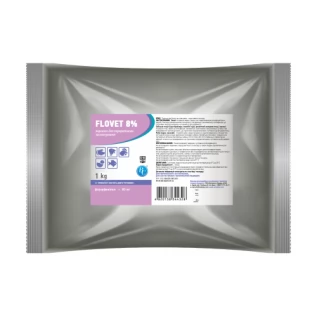Description
Powder of white to yellowish-brown color.
Composition
1 g of a drug contains active substance:
florfenicol – 80.0 mg.
Additive: lactose
Pharmacological properties
ATCvet classification code QJ01 –
antibacterial veterinary drugs for systemic use. QJ01BA90 – Florfenicol.
Florfenicol is derivative of
Thiamphenicol, active against gram-negative and gram-positive bacteria,
including: Staphylococcus spp.,
Streptococcus spp., Enterobacter spp., E. сoli, Pasteurella haemolytica, P.
multocida, P. piscicida, Vibrio spp., Haemophilus somnus, H. parasuis,
Fusobacterium necrophorum, Bacteroides melaninogenicus, Actinobacillus pleuropneumoniae,
Bordetella bronchiseptica, Salmonella spp., Klebsiella spp., Proteus spp.,
Shigella spp., Aeromonas salmonicida,
Campylobacter spp., Edwardsiella ictaluri, E. tarda, Flexibacter spp. etc.
Florfenicol is active against most mycoplasmas (Mycoplasma
hyopneumoniae, M.
hyorhinis etc.).
Mechanism of drug action is binding
70S by ribosome subunit, blocking peptidyl transferase enzyme, which results in
disruption of amino acid translation and subsequent stop of protein
biosynthesis in antibiotic-sensitive pathogens.
In case of oral use florfenicol is
well and quickly absorbed in gastrointestinal tract and spreads almost to all
organs and tissues, but the biggest level is observed in lungs, kidneys and
bile. Low concentration of florfenicol is shown in muscle tissue, liver, small
intestine, heart and blood serum.
Florfenicol bioavailability after
oral use in pigs is 88%. Maximum concentration of the antibiotic in blood is
achieved in 1 hour after oral administration. Therapeutic concentration after
oral administration is preserved in organs and tissues of an animal during 24
hours.
Florfenicol resistance develops
slowly.
Excreted from the body unchanged, mainly by glomerular filtration, also excreted unchanged into gastrointestinal tract with bile, inactivated by creating chelate bonds, and then excreted with feces
Application
Pigs: treatment of animals suffering
from pleuropneumonia, atrophic rhinitis, Glässer's disease (haemophilus
parasuis), pasteurellosis, salmonellosis, escherichiosis, caused by microorganisms
susceptible to florfenicol.
Poultry (broiler chickens, egg-laying
chickens, rearing stock, turkeys): treatment of poultry suffering from
escherichiosis, pasteurellosis, mycoplasmosis, salmonellosis, and respiratory
diseases, caused by pathogens susceptible to florfenicol.
Fish (carp, salmon): treatment of fish suffering from carp red spot disease (aeromonas infection, hemorrhagic septicemia), furunculosis (salmon aeromonosis) vibriosis, salmon haemophilus parasuis, pseudomonosis, pasteurellosis; secondary bacterial infections after stress or after the primary parasitic infections, and other diseases caused by pathogens susceptible to florfenicol.
Dosage
Orally with feed in doses of:
pigs – 0.5 kg of drug per 1000 kg of feed, which corresponds to 20 mg of florfenicol
per 1 kg of animal body weight daily for 7 days;
poultry (broiler chickens, egg-laying
chickens, rearing stock, turkeys) – 0.5 g of drug per 2 kg body weight, which
corresponds to 20 mg of florfenicol per 1 kg body weight daily for 5-7 days.
fish (carp, salmon) – 10.0 g of drug
per 80 kg of fish body weight (10 mg of florfenicol per 1 kg of fish body
weight) daily for 10 days. For small-sized and young fish daily dose of drug is
separated on 2 equal halves. When treating carps drug is previously mixed with
non-pelleted feed, which is then prepared into viscous mass for feeding.
Avoid long intervals between regular dose administration because it can cause loss of its efficiency. In case of missing one dose, drug administration is continued in the same dose by the same scheme.
Contraindication
Do not
use for animals, susceptible to florfenicol. Do not use for animals in
gestation or lactation periods, and boars meant for reproduction.
Do
not use for egg-laying chickens, eggs of which are used for human consumption.
Do
not use simultaneously with thiamphenicol or chloramphenicol, penicillin
antibiotics, cephalosporins, fluoroquinolones due to the possibility of
toxicosis occurrence.
Do
not use with sulfanilamides.
Do
not use during severe liver and kidneys function abnormalities.
Do not use for fish under water temperature lower than 5 °C.
Precautions
When
working with the drug it is required to use means of personal protection
(respirator, gloves).
During
treatment of pigs, redness may occur in perianal areas and soft stools. These
changes do not require treatment, vanish fast and do not affect the
physiological state of animals.
Use
of the drug for pregnant sows is acceptable only when drug sensitivity of the
pathogen is specified, and when the effect of the use exceeds possible economic
losses.
The
product is inconsistent with drugs containing cations Mg2+, Al3+,
Ca2+, as the latter bind with florfenicol and prevent its absorption.
Animal slaughtering for meet is permitted in 2 (pigs, poultry) days after the last drug administration. Fish consumption is permitted in 16 days (with water temperature from 5 °C to 10 °C) and in 8 days (with water temperature over 10 °C) after last drug administration, respectively. Meet and fish obtained before the specified time period is utilized and fed to unproductive animals, depending on the conclusion of a doctor of veterinary medicine.
Package
Bag of polyethylene film of 1, 2, 5,
10, 50, 100 and 500 g, 1 kg.
Sacks of 25 kg.
Polymer containers of 100 and 500 g, 1 kg.
Storage
Store in dry dark place under
temperature from 5 °C to 25 °C.
Keep away from children.
Expiration date – 3 years.
Expiration date after first opening
of the bag is 3 months providing storage conditions under temperature from 5 °C
to 25 °C in dry place, protected from light.
